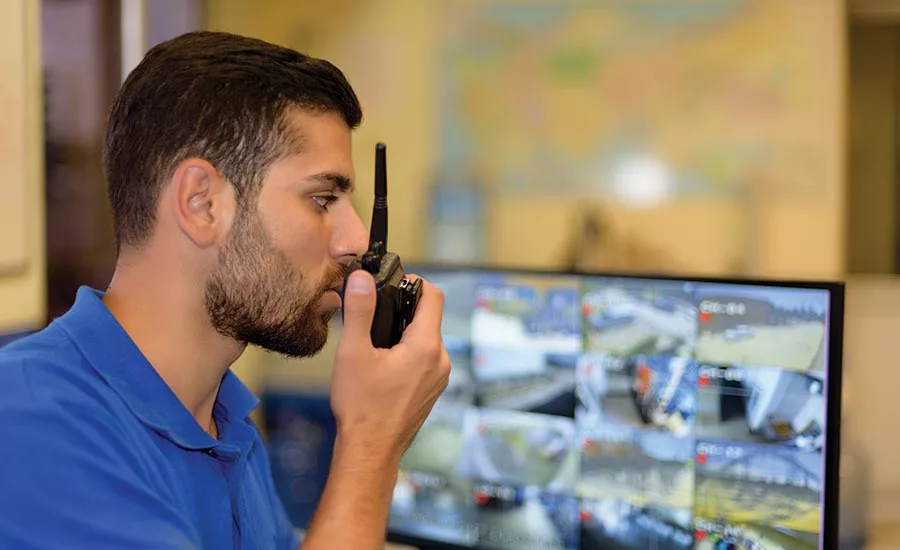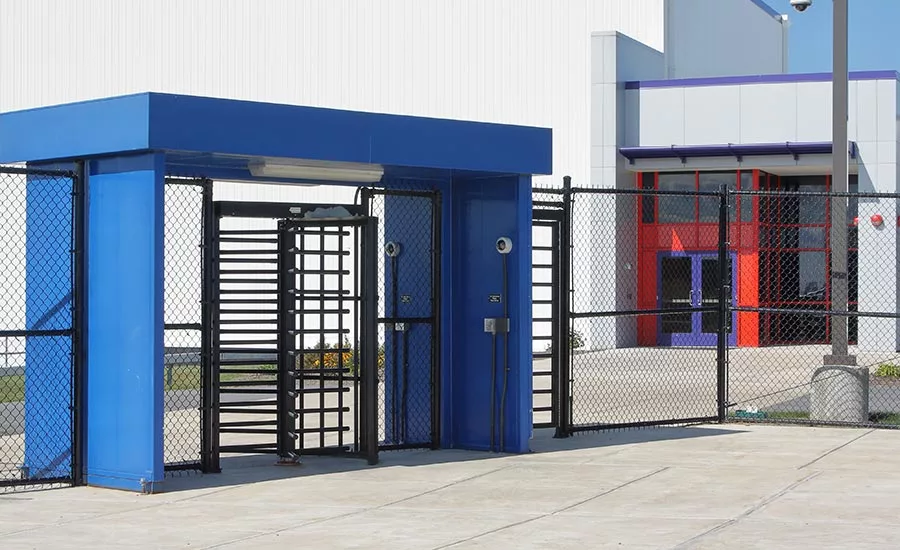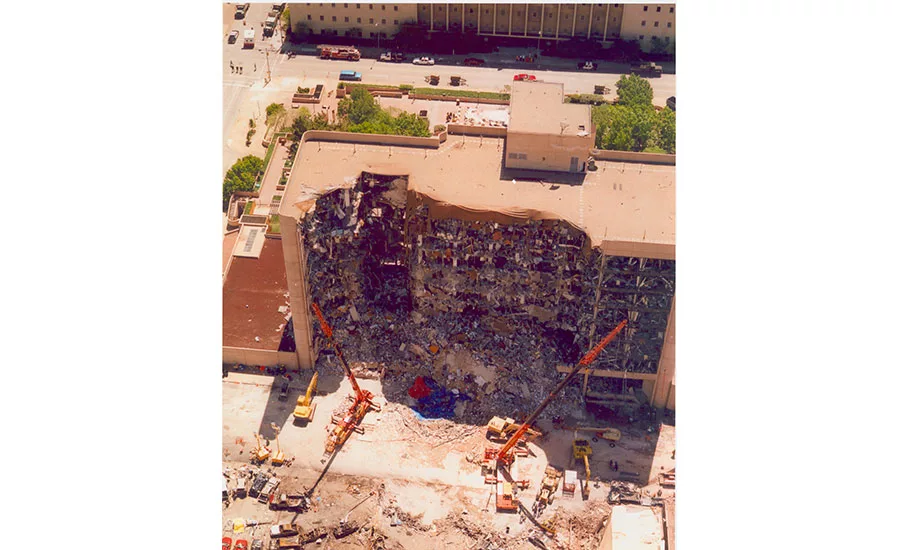Protecting against physical violence

A building’s design can incorporate many features to detect and keep out threatening people, and technology to analyze surveillance footage frees up security guards to focus on what humans do best: problem solving and investigation.
Photo courtesy of Getty Images

This facility requires card access at the entrance to pass through the full-height turnstile, outfitted with microphones and cameras, and yet another card access to enter the main plant area once inside the reception center. Truck access is through a guard shack on the side of the property.
Photo courtesy of Wayne Labs

The Alfred P. Murrah Federal Building in Oklahoma City was bombed by homegrown terrorists Timothy McVeigh and Terry Nichols in April 1995. The pair parked a rental truck filled with explosives right next to the building. The blast killed at least 168 people and injured more than 680 others.
Photo courtesy of the FBI
As I write this article on protecting employees from workplace violence, COVID-19 has certainly stolen the show. However, not long before the coronavirus pandemic bore its sights on the U.S., there was a horrible workplace shooting at the Molson Coors plant in Milwaukee where six people died—including the shooter.
With the way our news cycle works, even that workplace disaster—which took place near the end of February—seems a remote incident in the past, and a similar workplace shooting that happened at a Kraft Foods plant in Philadelphia in 2010 seems more like an event occurring a century ago. By the time you read this, hopefully the coronavirus will be starting to decline, having taught us all many things in learning how to deal with a pandemic.
While we can’t pretend to cover in one article what an entire publication devoted to security does, such as our sister magazine, Security, we will look at some key pointers in keeping employees safer in the workplace. But, keep in mind that we also have a pandemic of violence in our cities and workplaces, and the real fix goes beyond the technological and mechanical approaches we describe here.
Architectural methods to keep bad actors out
If you’re lucky enough to be building a new facility, being involved from the get-go has the best outcome for physical security professionals and facility owners, says Shaun Freeny, director of physical security for 1898 & Co., part of Burns & McDonnell. For physical security professionals, such involvement sees that the required infrastructure is in place and that physical security concepts are shared with the architect; for the facility owners, it is a cost-efficient approach—so that they do not spend extra money after the original build, only to go back and rework the plans.
If you need a really secure facility, Steve R. Knipper, R.A., senior project architect at Hixson, described some recommendations presented by the FBI at its newest state-of-the-art facility. These include positioning a facility away from interstate highways, railroads and truck parking areas; considering prevailing air currents that flow over and past a facility; and knowing your neighbors and what they manufacture. (For more, see the box, “FBI recommendations for facility design and procedures.”)
A concept called crime prevention through environmental design, or CPTED, is used to design so that a building and property looks and feels safe, adds Freeny. Strategies for CPTED include design for natural access control and natural surveillance and territory reinforcement to support the concept by deterring, detecting and delaying a potential adversary from entering the property.
One natural access control strategy is achieved by using shrubbery around a property, in addition to a fence or a sidewalk that leads to the entrance, essentially channeling the public on a specified path to enter the building. Natural access control can also be achieved with the design of traffic patterns onto the plant that can delay or even prohibit an adversary from gaining the necessary velocity to drive a vehicle aggressively into the plant.
Being able to see the receptionist or public area is a natural surveillance strategy supporting the concept of detection. Grounds should be kept well lit, especially parking areas and building entrances. Eliminate hiding spots and improve lines of sight by cutting down bushes and trimming trees to CPTED-prescribed heights. Use a strategy of territorial reinforcement to create a boundary between public areas and private areas that supports CPTED by deterring adversaries in the target selection phase, says Freeny. Use fences and reinforced gates to denote where private property begins.
Install access control card readers at the facility’s main and ancillary entrances to control physical access of personnel. Develop a visitor management procedure for visitors to the facility. Deliveries must also be subject to the visitor management procedure, says Freeny.
“Implement a visitor management system (VMS) that captures a copy of a person’s driver’s license,” says Evan Baker, data/fire/security systems department manager and senior associate for SSOE Group. Don’t allow visitor or employee vehicles within the plant property. RFID tagging can be used for authorized vehicles that use truck entry points.
Once entering on foot, provide secured entry vestibules where employees and visitors can be observed prior to gaining access to a facility, advises Baker. Implement full height turnstiles and require all employees to badge-in and badge-out of a campus or facility. This provides accountability on who is on-site and who is not in the event an emergency occurs.
It’s not just about keeping “bad guys” out, says Manny Valdivieso, AIA, director of architecture, Stellar (Design-Food & Beverage Division). It’s a matter of keeping them out while not creating bottlenecks or overcomplicating systems that limit efficiency and create unnecessary costs both up front and over time. For instance, employee entrances should be designed to be efficient conveyors of people and should promote order and clear visibility of each individual instead of allowing congestion, confusion and bottlenecking. Likewise, designing a facility that can be monitored with a limited number of cameras is far more effective at maintaining security than a facility that requires a multitude of cameras due to blind spots and obstructions that become impractical or too expensive to monitor.
What if you’re trying to retrofit an older facility? It all depends on whether your facility’s infrastructure can support a security upgrade now and into the future. Freeny suggests a few basic steps. First, ask the company’s physical security consultant or a verified security consultant to perform a risk and vulnerability assessment on the property. Then decide what specifically to protect and how to achieve it. Security professionals will then provide recommendations for hardware and software design and updates to security policies and procedures—and work with the chosen integrator and providers to bring the plant up to date.
“Work within the budget,” says SSOE’s Baker. Start with implementing the key control system, then gradually upgrade to electronic access control. Don’t forget to work with local unions to make sure they understand how the upgrades improve their safety.
Every existing facility will have unique needs, but generally speaking, facilities will benefit from providing as much clear space around the perimeter as is practical, says Stellar’s Valdivieso. This can be achieved by clearing unnecessary landscaping and hardscaping elements as well as relocating temporary storage units, equipment staging areas or any other physical elements that inhibit the visibility of threats from security systems. Additionally, limiting vehicle access with bollards and adding window tints to obscure visibility into the building are simple yet effective interventions that increase an existing facility’s defenses against threats.
Strategies to dissuade bombs
That brings us to a quick discussion about vehicular bombs, aka a VBIED or “vehicle-borne improvised explosive device,” as Freeny describes it. Such an event has already happened here. The bombing of the Alfred P. Murrah Federal Building in Oklahoma City in April 1995 by home-grown terrorists Timothy McVeigh and Terry Nichols showed the damage that could be done with an explosives-filled rented Ryder truck.
Of course, this may never happen to your facility, but how can you protect your assets? “A great first step is to increase the distance between areas with vehicle access and occupied spaces of the building as much as possible,” says Stellar’s Valdivieso. Not only does this help reduce the impact from a potential blast originating from a vehicle, it can also increase the opportunity for spotting suspicious behavior approaching the building. Additionally, exterior wall assembly types and the type and configuration of windows can play an important role in mitigating the impact from blasts.
Blast-resistant glass can significantly alter the weight distribution of a window and its surrounding components due to its excessive weight and can be costly to install during a retrofit, says Freeny. Concrete is not aesthetically pleasing and may block natural surveillance views. One of the more cost-effective measures is the use of bollards, which are available in different materials and styles. Following the correct vehicle bollard or gates crash ratings can help determine the type of protection needed and the proper standoff distance to see that vehicles are not able to get near the plant or site.
CPTED design principles also provide adequate stand-off distances of vehicles from critical components within a facility, says SSOE’s Baker. Tree lines, planters and berms can also be used to restrict vehicle traffic.
Use monitoring technology discreetly
Software technology advances have created ways for facilities to use cameras for different analytics, says Jon Phillips, director of electrical engineering at Stellar. Should a facility like to use the technology for personnel recognition, location and movement of people/assets, or facility navigation, a video system with advanced software is up to the task.
Besides video monitoring systems (early versions known as CCTV), a world of new technological monitoring tools can warn of dangers. Julie Brown, market leader for Johnson Controls Building Solutions North America, describes some: Advanced monitoring technologies, such as weapons and gunshot detection and screening, leverage the latest AI capabilities to keep security personnel one step ahead of any threats. By connecting building systems through a building automation system (BAS), systems including access controls, video surveillance, lighting, mass notification systems, and fire and life safety technologies can be automated during an emergency.
Effectively managing access to the food manufacturing or distribution facility starts with an integrated and converged technology solution that provides a universal digital identity to people and things and extends that identity across the entire ecosystem in a secure, intelligent and efficient way, says Willem Ryan, vice president of marketing and communications at AlertEnterprise Inc. Starting at the farthest reaches of a property’s perimeter, access governance with identity credentialing qualifies visitors and ascertains whether they have legitimate access. Securing the food supply chain also means correlating threats across underlying HR, IT, physical security and OT.
For example, actively monitoring and recording warehouse access by employees and contractors further prevents materials threats or threats to production, including sabotage, acts of terrorism and other malicious incidents. With preregistration of contractors, temporary workers and distribution personnel, facilities can proactively address insider threats by keeping the bad guys out in the first place, says Ryan.
Integrated solutions directly influence positive outcomes during emergency situations by improving the speed and success of the occupants’ evacuation and first responders’ actions, adds Brown. Both privacy and threat protection should always be a priority, and with innovative monitoring solutions, both can be addressed.
Video surveillance is a good method of monitoring areas to strengthen safety and security for employees, and there are a range of opinions on the subject. “Legally speaking, most local, county, state and federal laws allow the use of cameras unless there is a very specific and reasonable expectation of privacy,” says Freeny. As a rule, the expectation of privacy exists in bathrooms, shower rooms, locker rooms and hotel rooms, to name a few.
People today have learned to deal with the fact that they are almost always in view of a video surveillance camera wherever they go, says SSOE’s Baker. “I would advise against putting cameras in the direct areas where employees are performing their job responsibilities. This conveys a sense of distrust from the employer toward the employee that they feel that they’re not doing their job.” As with anything new, when deploying a new camera system there needs to be communication from the employer to staff members to help them understand why the system is being installed.
Security guards’ changing role
Security guards continue to play an important role in protecting our buildings and environments. Though integrated technologies have helped the role of the security guard evolve over the years, human beings remain an important part of the solution, says Johnson Controls’ Brown. Certain aspects of a security plan, like life safety alarms, should be automated to reduce the potential for human error, though it is still imperative to have security guards to address these threats while keeping them and everyone else in the building safer.
Technologies like AI and machine learning can monitor and analyze hours of video surveillance footage and large volumes of building data, adds Brown. This frees up security guards to focus on what humans do best: problem solving and investigation. Combining the processing power of AI with the critical thinking of trained security guards ensures buildings are effectively protected.
Properly training security guards and occupants on emergency and evacuation procedures allows them to feel confident in their ability to act intuitively in the case of an emergency. These technologies give them the tools they need to be most effective in their positions, says Brown.
A security guard must diffuse and delay the perpetrator until law enforcement arrives, says SSOE’s Baker. Many companies have now begun to arm officers. This requires thorough risk evaluation and typically is done by an outsourced guard service company.
Security guards today also need to be behavioral experts, especially through observation. In recent years, it’s become necessary to report behavior changes in employees, visitors and vendors, says a Securitas consultant. “Workforce behavior” reporting doesn’t indicate a major event, but documents the officer’s (guard’s) observation. When “John” normally enters with a smile daily and is usually observed on the park bench at noon every day that may not necessarily be an issue. However, changes in emotional states, short fuses and talking of violent events in excess may be a cause for concern.
Work with disgruntled employees
Disgruntled workers may not always cause overt physical harm, but can still do significant damage in other ways.
AlertEnterprise’s Ryan relates such a case at a large food company that was dealing with a disgruntled production foreman. “Tom” not only had physical access to the production floor but was intimately familiar with the control system settings to configure recipes for the MES.
AlertEnterprise security software’s real-time link to SAP SuccessFactors HCM provided critical real-time data that identified Tom’s history of workplace issues.
When Tom accessed the plant area after his normal shift hours, the software detected that he was making changes to production settings to eliminate the addition of preservatives. An alert was immediately sent to Security Operations and the plant manager. Incident prevented, with huge savings from avoided downtime and protection from loss or reputation to the company’s brand, says Ryan.
Disgruntled workers, however, can take violent revenge for several reasons, but two looming examples are the case of the suspended Kraft employee (See FE, May 2014), who came back shooting and the Molson Coors electrician who killed five coworkers and himself.
Today, most large companies have a well-structured system for laying off people, which consists of, for example, disabling key cards, shipping employee materials home, mailing a severance package, using a special room for exit interviews and working, with HR and the security team to ensure a safe exit—and no return to the premises with a weapon.
In the case of Anthony Ferrill, the Molson Coors electrician, Ferrill was said to have a long-running dispute with a coworker who accused of him of watching movies on his phone rather than working, according to an article in the Milwaukee Journal Sentinel, Feb. 28, 2020. Other coworkers suggested Ferrill believed fellow workers were coming into his home and bugging his computer, while another coworker thought Ferrill seemed fine. It was also reported that Ferrill had often complained of chronic back pain, and having to do a lot of walking to various far-flung buildings on the campus with heavy equipment.
But employees seldom “snap” for no reason, as there are usually subtle—often nonverbal—indicators and/or events leading up to a major crisis event. Fellow workers need to be sensitive and tuned in to the clues a troubled employee may display and let supervisors and management know before a situation gets out of hand. See the box, “Warning signs of troubled employees.”
Preventing a catastrophe may come down to the simple advice from the Department of Homeland Security: “If you see something, say something.” From OSHA’s “Workplace Violence” factsheet, “Alert supervisors to any problems about safety or security and report all incidents immediately in writing.” But could caring and concern for our neighbors and fellow workers help to minimize these incidents?
For more information:
1898 & Co., https://1898andco.burnsmcd.com
AlertEnterprise Inc., www.alertenterprise.com
Hixson Architecture & Engineering, www.hixson-inc.com
Johnson Controls Building Solutions North America, www.johnsoncontrols.com
Securitas, www.securitasinc.com
SSOE Group, www.ssoe.com
Stellar, www.stellar.net
Looking for a reprint of this article?
From high-res PDFs to custom plaques, order your copy today!







